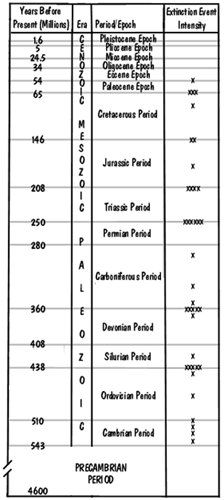TROPICAL RAINFORESTS: Disappearing Opportunities
Historic Mass Extinctions
|
|
|
Adapted from Raup 1991. |
In the history of life on earth there have been numerous mass extinctions. A mass extinction is recognized as an interval of one to several million years where an unusually high number of "unrelated groups from a number of habitats, terrestrial as well as marine" become extinct.
No one knows what actually causes mass extinctions, although there is a great deal of speculation. There is a consensus among many paleontologists that extra-terrestrial objects, like meteorites and comets, have played a significant role in past extinction events. For example, often cited for the demise of the dinosaurs is the impact of a 6-mile (10-km) wide meteorite near the Yucatan, Mexico. There is substantial evidence (iridium anomalies, craters, and shattered quartz fragments) to support such theories and there is good reason to believe that such an impact could create conditions (shock waves, tsunamis, forest fires, acid rain, darkness lasting months or years, global cooling or warming) to eliminate a large portion of the world's species. Other leading theories to causes of mass extinctions include: global climate change, changes in sea level, chemical poisoning of the atmosphere and/or oceans, variation in solar radiation, and extreme volcanic activity.
Two thousand years ago there were more species on Earth than ever before.
Earth's biodiversity has reached a peak and now it is declining into what many ecologists and biologists are calling
the sixth great extinction. Today species are being driven to extinction at a rate higher than any time in the
past.
| Extinction Event |
Years Before Present (millions) |
Families Lost |
Recovery Time (millions of years) |
| Cretaceous-Tertiary |
66 |
15% of 650 |
20 |
| Triassic |
213 |
20% of 300 |
** |
| Permian |
250 |
30% of 400 |
100 |
| Devonian |
360 |
22% of 450 |
30 |
| Ordovician |
440 |
22% of 450 |
25 |
Recovery time refers to the amount of time necessary for the number of species/families to reach the level that existed prior to the event.
**The Triassic and Permian extinction events are often combined as the
Permo-Triassic event because of the short duration between the two extinctions. During this period 76-96% of species
died out.
Continued: Extinction
